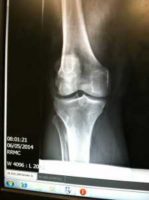Author Interviews, Orthopedics, Pain Research, Rheumatology / 02.05.2018
Which NSAID for Knee Pain Works Best?
MedicalResearch.com Interview with:
 Deborah S. Cummins, PhD
Director, Research, Quality and Scientific Affairs
American Academy of Orthopaedic Surgeons
On behalf of the researchers:
David Jevsevar, MD, MBA; Gregory A. Brown, MD, PHD, and Deborah S. Cummins, PhD
MedicalResearch.com: What is the background for this study? What are the main findings?
Response: It is estimated that individuals have a 45% risk of developing knee osteoarthritis (OA) in their lifetime. As a result of the shifting demographics of the US, where an increasing percentage of the population is older than 65, the burden of knee OA will continue to increase. To help deal with this burden, effective nonsurgical treatments are needed to manage knee OA symptoms associated with pain and function before surgical intervention becomes necessary. To determine which non-surgical options are best, we performed a network meta-analysis exploring mixed treatment comparisons for nonsurgical treatment of knee osteoarthritis in order to effectively rank the various nonsurgical treatment options from best to worst.
Our network meta-analysis suggests that the single most effective nonsurgical treatment for improving knee function is function is naproxen, followed by diclofenac, celecoxib, and ibuprofen. When considering pain and function together, our data suggest that naproxen is the most effective treatment followed by IA corticosteroid injection.
The single most effective short-term (4-6 weeks) treatment for decreasing pain is intra-articular (IA) corticosteroid injection, followed by ibuprofen, IA platelet rich plasma, and naproxen. Additionally, intra-articular hyaluronic acid injections never achieved a rank in the top five treatments for pain, function, or combined pain and function. An analysis of 12 articles also found that HA is not significantly different than IA placebo in effect.
(more…)
Deborah S. Cummins, PhD
Director, Research, Quality and Scientific Affairs
American Academy of Orthopaedic Surgeons
On behalf of the researchers:
David Jevsevar, MD, MBA; Gregory A. Brown, MD, PHD, and Deborah S. Cummins, PhD
MedicalResearch.com: What is the background for this study? What are the main findings?
Response: It is estimated that individuals have a 45% risk of developing knee osteoarthritis (OA) in their lifetime. As a result of the shifting demographics of the US, where an increasing percentage of the population is older than 65, the burden of knee OA will continue to increase. To help deal with this burden, effective nonsurgical treatments are needed to manage knee OA symptoms associated with pain and function before surgical intervention becomes necessary. To determine which non-surgical options are best, we performed a network meta-analysis exploring mixed treatment comparisons for nonsurgical treatment of knee osteoarthritis in order to effectively rank the various nonsurgical treatment options from best to worst.
Our network meta-analysis suggests that the single most effective nonsurgical treatment for improving knee function is function is naproxen, followed by diclofenac, celecoxib, and ibuprofen. When considering pain and function together, our data suggest that naproxen is the most effective treatment followed by IA corticosteroid injection.
The single most effective short-term (4-6 weeks) treatment for decreasing pain is intra-articular (IA) corticosteroid injection, followed by ibuprofen, IA platelet rich plasma, and naproxen. Additionally, intra-articular hyaluronic acid injections never achieved a rank in the top five treatments for pain, function, or combined pain and function. An analysis of 12 articles also found that HA is not significantly different than IA placebo in effect.
(more…)
 Deborah S. Cummins, PhD
Director, Research, Quality and Scientific Affairs
American Academy of Orthopaedic Surgeons
On behalf of the researchers:
David Jevsevar, MD, MBA; Gregory A. Brown, MD, PHD, and Deborah S. Cummins, PhD
MedicalResearch.com: What is the background for this study? What are the main findings?
Response: It is estimated that individuals have a 45% risk of developing knee osteoarthritis (OA) in their lifetime. As a result of the shifting demographics of the US, where an increasing percentage of the population is older than 65, the burden of knee OA will continue to increase. To help deal with this burden, effective nonsurgical treatments are needed to manage knee OA symptoms associated with pain and function before surgical intervention becomes necessary. To determine which non-surgical options are best, we performed a network meta-analysis exploring mixed treatment comparisons for nonsurgical treatment of knee osteoarthritis in order to effectively rank the various nonsurgical treatment options from best to worst.
Our network meta-analysis suggests that the single most effective nonsurgical treatment for improving knee function is function is naproxen, followed by diclofenac, celecoxib, and ibuprofen. When considering pain and function together, our data suggest that naproxen is the most effective treatment followed by IA corticosteroid injection.
The single most effective short-term (4-6 weeks) treatment for decreasing pain is intra-articular (IA) corticosteroid injection, followed by ibuprofen, IA platelet rich plasma, and naproxen. Additionally, intra-articular hyaluronic acid injections never achieved a rank in the top five treatments for pain, function, or combined pain and function. An analysis of 12 articles also found that HA is not significantly different than IA placebo in effect.
(more…)
Deborah S. Cummins, PhD
Director, Research, Quality and Scientific Affairs
American Academy of Orthopaedic Surgeons
On behalf of the researchers:
David Jevsevar, MD, MBA; Gregory A. Brown, MD, PHD, and Deborah S. Cummins, PhD
MedicalResearch.com: What is the background for this study? What are the main findings?
Response: It is estimated that individuals have a 45% risk of developing knee osteoarthritis (OA) in their lifetime. As a result of the shifting demographics of the US, where an increasing percentage of the population is older than 65, the burden of knee OA will continue to increase. To help deal with this burden, effective nonsurgical treatments are needed to manage knee OA symptoms associated with pain and function before surgical intervention becomes necessary. To determine which non-surgical options are best, we performed a network meta-analysis exploring mixed treatment comparisons for nonsurgical treatment of knee osteoarthritis in order to effectively rank the various nonsurgical treatment options from best to worst.
Our network meta-analysis suggests that the single most effective nonsurgical treatment for improving knee function is function is naproxen, followed by diclofenac, celecoxib, and ibuprofen. When considering pain and function together, our data suggest that naproxen is the most effective treatment followed by IA corticosteroid injection.
The single most effective short-term (4-6 weeks) treatment for decreasing pain is intra-articular (IA) corticosteroid injection, followed by ibuprofen, IA platelet rich plasma, and naproxen. Additionally, intra-articular hyaluronic acid injections never achieved a rank in the top five treatments for pain, function, or combined pain and function. An analysis of 12 articles also found that HA is not significantly different than IA placebo in effect.
(more…)

